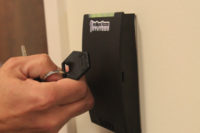Unified security systems are one of the industry’s latest buzzwords. But beyond the hype, what do these types of systems offer the security integrator and, ultimately, the customer? Plenty, say the experts.
From cloud-based RMR to making yourself essential to the customer and providing them with key business intelligence, there are no shortage of reasons to consider offering a unified approach to your customer. If done correctly they are easier to plan for, install and maintain; are flexible and scalable; and can set you apart from those selling point solutions to problems.
SDM gathered four manufacturers that offer unified security solutions for a roundtable discussion to learn about the latest trends, find out what integrators should know, and gather any advice they might offer as you look for the right system for you and your customer. Participants included: Justin Wilmas, senior director of global sales, AMAG Technology, Torrance, Calif; Alex Asnovich, vice president, global marketing and communications, Avigilon Corporation, Vancouver, British Columbia; Jean-Pierre Picard, manager of product marketing, Genetec, Montreal; and Michael Coniff, senior product marketing manager, Honeywell Building Technologies, Atlanta.
SDM: What is a unified system and how is it different from an integrated system?
Picard: Unification is not the same as integration. Unified systems will actually go beyond just synchronizing signals and consolidating data in ways that can actually learn from that data and identify trends. That is not possible with integration. If you start with integration you will hit a wall at one point.
Wilmas: A unified system consists of one platform where all systems operate together through the same interface. In recent years, companies have expanded their offerings to include identity management, visitor management, incident management and command and control. Unified systems consist of these systems, along with access control and video management, and operate through a single interface. Today, manufacturers are offering more solutions to help mitigate risk, meet compliance and save money.
Asnovich: A unified system today is designed to bring the most important events and insight to users’ attention, freeing them to do what they do best: take action to make critical decisions.
Coniff: We look at a unified system from a whole-building perspective. How are they going to manage access into that building? How are they going to manage their comfort in that building? It is about ease of access, simplicity, connectivity.
SDM: What are some of the latest trends or developments in unified systems today?
Coniff: Where I think it is changing is over time end users who have these disparate technologies and different pieces of software find it difficult to access and monitor as they become more mobile. The shift is that end users have started to become more demanding in how they work and ease of access to these systems. They no longer accept three different pieces of software. Their daily lives have become “click on an app and access my banking.” These same end users are managing their sites looking for a single point to log in. We are now approaching this from the perspective of how that market is shifting. That is why we moved our tech towards cloud, because it inherently provides that functionality to those end users.
Picard: Making sense of data is a challenge; but it gets even trickier when they are out in the field. The way mobile apps can help collaborate with central office is underestimated. We are seeing more questions from customers about what they want to do with the mobile app and always around collaboration and keeping a link between central office and people in the field. If you have everything at a desk it’s one click away; but it is not the same out in the field.
Wilmas: Companies are offering command and control options with their access control and video to provide a single user interface to manage their security operations. We are also seeing manufacturers enter the market with analytics offerings, which utilize artificial intelligence and machine learning to provide business intelligence. Customers will obtain a better understanding of what’s happening inside their business and receive notifications when anything unusual occurs.
SDM: How do unified systems benefit security integrators and their customers?
Asnovich: Unification has the potential to significantly impact security operations. The tremendous value of unification has positioned it as an important component to help streamline security systems today. With unification, the integrator creates an easier system setup, less margin of error, and the end customer benefits from having a seamless experience with the ability to control all security-related functions from a single user interface.
Picard: It simplifies parts of their work that don’t drive significant customer value. Installing a unified system is much more efficient than installing disparate systems. You don’t have to set up multiple systems and deal with upgrading and maintaining all those systems. Integrators today differentiate themselves by really tailoring the behavior of the system to achieve a vision that is unique to the customer. When you give them the option to offer expertise in consulting instead of installing software or troubleshooting they can establish a better customer relationship and ultimately become a trusted partner.
Coniff: End users are looking to be able to get the right insight at the right time. Instead of having to constantly think about what they are searching for they are looking more for that technology and that system to be helping them do their daily job, looking for efficiencies and reducing operational costs, an easier way to interact with their businesses. The trend is more about the end user that has a million things to do in their day and says, “Help me make that easier. Give me notifications. Tell me about exceptions within a facility. Help me manage my building better.”
SDM: What advice would you give security integrators on how best to approach a unified system with their customer?
Wilmas: Integrators need to see the big picture before jumping into an integration. By understanding the long-term goals of the customer, they can offer a solution that will meet their customer’s needs for the next 10 to 15 years. Ask questions and think beyond security. How can their systems help their business operations? By understanding the big picture and providing the right solution, they will have that customer for a long time.
Coniff: End users have a lot of options today. What dealers and integrators already know and see is that attrition and less stickiness within their systems. The end user is saying, “OK so you have a video system. Five other companies have that same video system. What is different about what you are offering?” Dealers have the ability to go in and show something that is truly a different value to the end user. That is the key. Instead of going in and selling on features of one product that is just about price, know there is a better way. We are starting to see dealers going in and presenting that unified offering and if not doing it today they should reach out to manufacturers they trust and learn more about how to go in and demonstrate this offering. Give the end user a better way of managing their system. Then the conversation goes from, “How much are you charging me for this widget?” to “This is great and how much are you charging [as a management fee] to do that?” It is a better value.
Asnovich: Integrators have a very important role of liaising between the customer and the manufacturer. Planning, and ensuring they are constantly consulting with their customers throughout the project are essential to the success of integration projects.
Picard: One of the things we have noticed is it is an ongoing project. It is not something you do all at once. If you look at the existing system go with a first phase where you migrate key components. You can’t forget that it is a significant change in the experience for operators who have really crucial day-to-day tasks they need to accomplish. Start with two systems then expand to maybe intrusion or communication systems or more niche systems like gunshot detection. Start applying those layers of workflows and automation. Eventually once the customer is really comfortable with the unified platform, the next logical step is focusing on intelligence and gaining insights into operations and data. But you can’t start that on day one. It is often a multi-year journey, but there are gains right away.
More Online
For more on unified system visit SDM’s website where you will find the following articles:
“Understanding Unified Systems”
www.SDMmag.com/understanding-unified-systems
“Top Trends in Unified Security Systems and How Integrators Can Benefit”
www.SDMmag.com/top-trends-in-unified-security-systems
“What Do Enterprise Security Customers Want?”
www.SDMmag.com/what-do-enterprise-customers-want









